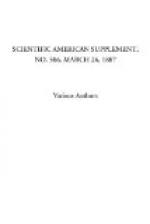With respect to ammoniacal dissolution, which I will briefly mention, a rod composed of an alloy of copper and silver was experimented upon, the copper becoming entirely dissolved and precipitating itself on the platinum electrode, the whole of the silver remaining suspended to the positive electrode in an aborescent form. Arsenide of zinc was similarly treated, the arsenic becoming precipitated in like manner on the platinum electrode. Various other alloys, being experimented upon, gave similar results.
I may also, in the last instance, mention that I have found the above methods of electro-dissolution peculiarly adapted for the preparation of unstable compounds such as stannic nitrate, potassic ferrate, ferric acetate, which are decomposed on the application of heat, and in some instances have succeeded by the following means of crystallizing the resulting compound obtained.—Chem. News.
* * * * *
A NEWLY DISCOVERED SUBSTANCE IN URINE.
Dr. Leo’s researches on sugar in urine are interesting, and tend to correct the commonly accepted views on the subject. Professor Scheibler, a chemist well known for his researches on sugar, has observed that the determination of the quantity of that substance contained in a liquid gives different results, according as it is done by Trommer’s method or with the polariscope. As sugar nowadays is exclusively dealt with according to the degree of polarization, this fact is of enormous value in trade. Scheibler has isolated a substance that is more powerful in that respect than grape sugar. Dr. Leo’s researches yield analogous results, though in a different field. He has examined a great quantity of diabetic urine after three different methods, namely, Trommer’s (alkaline solution of copper); by fermentation; and with the polarization apparatus. In many cases the results agreed, while in others there was a considerable difference.
He succeeded in isolating a substance corresponding in its chemical composition to grape sugar, and also a carbo-hydrate differing considerably from grape sugar, and turning the plane of polarization to the left. The power of reduction of this newly discovered substance is to that of grape sugar as 1:2.48. Dr. Leo found this substance in three specimens of diabetic urine, but it was absent in normal urine, although a great amount was examined for that purpose. From this it may be concluded that the substance does not originate outside the organism, and that it is a pathological product. The theory of Dr. Jaques Meyer, of Carlsbad, that it may be connected with obesity, is negatived by the fact that of the three persons in whom this substance was found, only one was corpulent.




